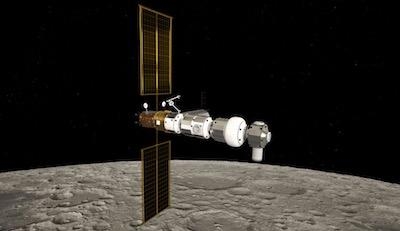ESA-Backed Research Studies Feasibility As A Deployment Point For Planetary Defense Missions
Humankind’s next space outpost, the lunar Gateway, will serve as a staging point to reach the surface of the Moon. A new ESA-backed study is considering whether it could also be used as a deployment point for planetary defence missions, to intercept asteroids approaching dangerously close to Earth.

Set for assembly over the course of this decade, the Gateway will be placed in a highly elongated, or ‘eccentric’ week-long orbit around the Moon. Crewed missions will require much less energy to rendezvous with the Gateway than to fly direct to the surface of the Moon, and could then venture down using Gateway-based landers.
But the Gateway could also support operations into deep space – including spacecraft for planetary defence, to deflect the orbital paths of incoming asteroids.
The concept might sound like science fiction, but Earth’s first planetary defence missions are already in active preparation. NASA’s Double Asteroid Redirect Test (DART) spacecraft, due to launch next year, will impact the smaller of the Didymos asteroid pair, in orbit between Earth and Mars, in a bid to shift its orbit. In 2026 ESA’s Hera spacecraft will perform a close-up survey of the asteroid post-impact.
The DART and Hera missions, known jointly as the Asteroid Impact and Deflection Assessment (AIDA) collaboration represent an experimental trial-run on a distant body that poses no threat to Earth. Once proven, the deflection technique could be used for real on asteroids coming dangerously close – but a rapid reaction time would be crucial for maximum effectiveness.
Accordingly ESA is funding a new study by Politechnico di Milano to analyse options for using the Gateway to park planetary defence spacecraft in readiness to intercept incoming asteroids. These spacecraft would be able to depart the Gateway with much lower energies compared with departing from Earth itself.
“This promising study comes out of one of the latest ideas received through ESA’s Open Space Innovation Platform, OSIP,” explains Moritz Fontaine, the Agency’s Discovery and Preparation Officer. “Using OSIP, anyone is welcome to propose novel ideas to address space-related challenges.
“We channel the most promising ideas through appropriate ESA implementation paths. Ideas can come from anyone: specialist researchers, companies or members of the public. Although OSIP was launched less than a year ago, we have already received hundreds of proposals.”
Other OSIP-submitted research ideas selected for funding in January 2020 include:
- New ways of building satellites might be creating a new type of space debris: the latest carbon fibre reinforced plastics, when broken apart, could be giving rise to vast amounts of tiny fragments of carbon fibres. These are not represented in current debris models, so a dedicated model needs to be made
- Air-filled integrated waveguides could enable the design of low-cost, high performance antennas for the coming wave of satellite constellations
- The autonomy of embedded devices aboard satellites could be boosted using AI-based hardware accelerators
- With nanomaterials used increasingly for biomedical applications, investigation is needed into how weightlessness influences their effects within biological systems.
(Image provided with ESA news release)
 NTSB Prelim: Hy-Tek Hurricane HP
NTSB Prelim: Hy-Tek Hurricane HP ANN's Daily Aero-Term (05.14.25): Flight Check
ANN's Daily Aero-Term (05.14.25): Flight Check Aero-News: Quote of the Day (05.14.25)
Aero-News: Quote of the Day (05.14.25) ANN's Daily Aero-Term (05.15.25): Primary Radar
ANN's Daily Aero-Term (05.15.25): Primary Radar Airborne 05.12.25: $1M Flying Car, Marion Airport Saved, AirVenture Cup
Airborne 05.12.25: $1M Flying Car, Marion Airport Saved, AirVenture Cup



